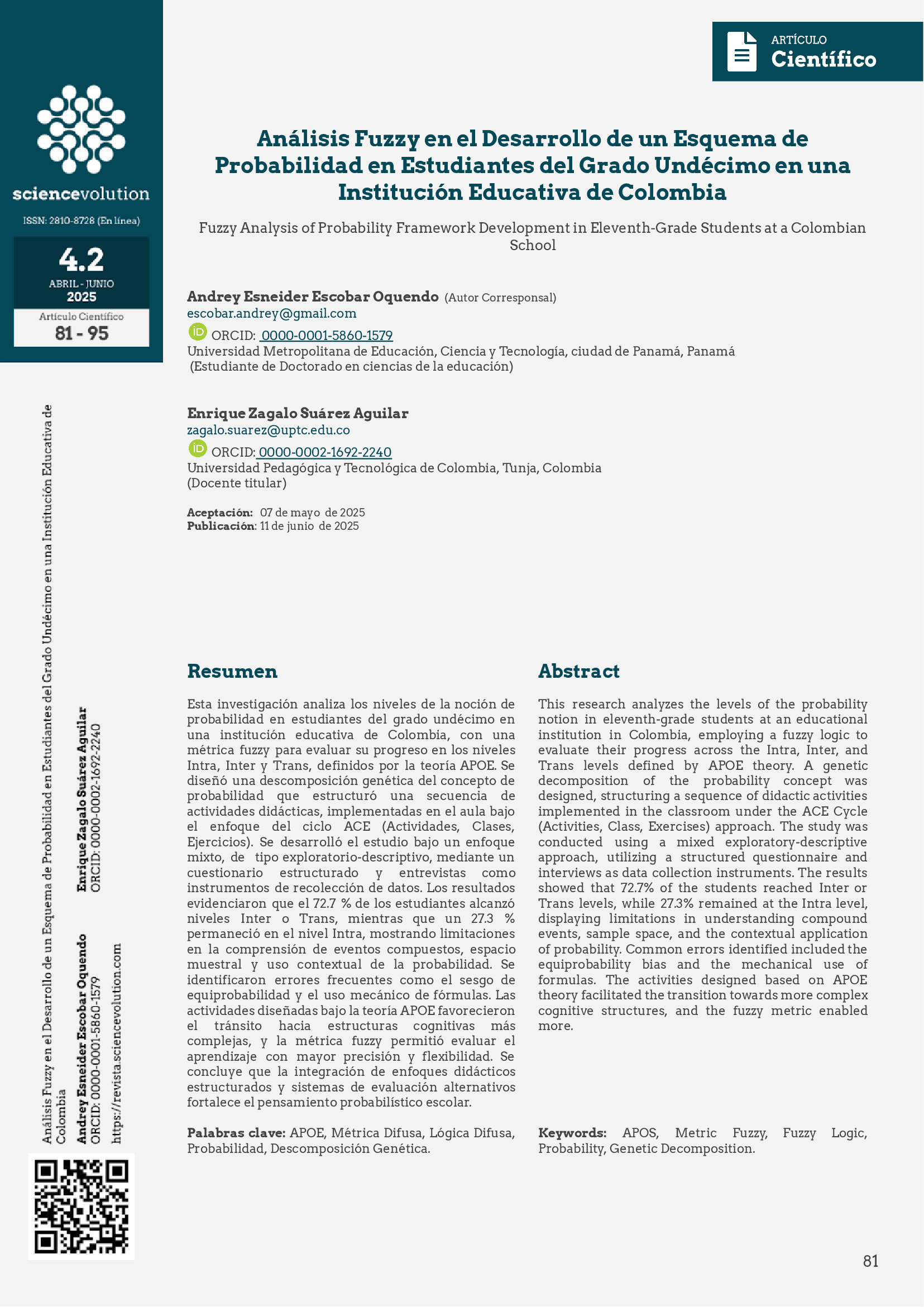Abstract
This research analyzes the levels of the probability notion in eleventh-grade students at an educational institution in Colombia, employing a fuzzy logic to evaluate their progress across the Intra, Inter, and Trans levels defined by APOE theory. A genetic decomposition of the probability concept was designed, structuring a sequence of didactic activities implemented in the classroom under the ACE Cycle (Activities, Class, Exercises) approach. The study was conducted using a mixed exploratory-descriptive approach, utilizing a structured questionnaire and interviews as data collection instruments. The results showed that 72.7% of the students reached Inter or Trans levels, while 27.3% remained at the Intra level, displaying limitations in understanding compound events, sample space, and the contextual application of probability. Common errors identified included the equiprobability bias and the mechanical use of formulas. The activities designed based on APOE theory facilitated the transition towards more complex cognitive structures, and the fuzzy metric enabled more.
References
Arnesen, K. K., & Skartsæterhagen, Ø. I. (2025). Mathematical induction in education research: A systematic review. Educational Studies in Mathematics, 119, 79–100. https://doi.org/10.1007/s10649-024-10373-x
Asiala, M., Brown, A., DeVries, D. J., Dubinsky, E., Mathews, D., & Thomas, K. (2026). A framework for research and curriculum development in undergraduate mathematics education. In J. Kaput, A. H. Schoenfeld, & E. Dubinsky (Eds.), Research in Collegiate Mathematics Education II (pp. 1–34). American Mathematical Society. https://www.math.kent.edu/~edd/Framework.pdf
Blanco-Benamburg, R., Palma-Picado, K., & Moreira-Mora, T. E. (2021). Estrategias cognitivas ejecutadas en la resolución de problemas matemáticos en una prueba de admisión a la educación superior. Educación Matemática, 33(1), 240–267. https://www.redalyc.org/journal/405/40576157010/40576157010.pdf
Borji, V., Sánchez, A., Font, V. y Garcés, W. (2021). Un estudio sobre la comprensión de los estudiantes de la derivación implícita, basado en APOE y EOS. En Diago, P. D., Yáñez D. F., González-Astudillo, M. T. y Carrillo, D. (Eds.), Investigación en Educación Matemática XXIV (pp. 173– 180). Valencia: SEIEM. https://www.seiem.es/docs/actas/24/ActasXXIVSEIEM.pdf
Castellanos Contrera, J. U., Pareja Figueredo, C. F., & Gutierrez Martinez, L. C. (2020). Modelo basado en lógica difusa para la construcción de condiciones de alta calidad en el sistema educativo. CITAS, 6(1) 1-7. https://doi.org/10.15332/24224529.6360
Escobar Pérez, S. E., Flores Andino, V. M., & Pérez Insuasti, J. J. (2024). Uso de la teoría APOE para el aprendizaje y comprensión de las matemáticas. Polo del Conocimiento, 9(9), 3557–3575. https://doi.org/10.23857/pc.v9i9.8342
Fernández Coronado, N. A., & García-García, J. I. (2024). Sentido probabilístico: Un primer acercamiento. En M. Sánchez Aguilar, M. del S. García González, & A. Castañeda (Eds.), Perspectivas actuales de la educación matemática (pp. 107–116). Editorial SOMIDEM. https://doi.org/10.24844/SOMIDEM/S3/2024/01-10
García-García, J. I., Fernández Coronado, N. A., & Imilpán Rivera, I. A. (2020). Desarrollo del razonamiento probabilístico en profesores de matemáticas mediante simulación computacional. Revista Paradigma, 41 (2), 404–426. https://doi.org/10.37618/PARADIGMA.1011-2251.0.p404-426.id917
George, A., & Veeramani, P. (1994). On some results in fuzzy metric spaces. Fuzzy Sets and Systems, 64(3), 395–399. https://doi.org/10.1016/0165-0114(94)90162-7
Huerta, M. P. (2020). Hipótesis y conjeturas en el desarrollo del pensamiento estocástico: Retos para su enseñanza y en la formación de profesores. Revista Latinoamericana de Investigación en Matemática Educativa, 23(1), 79–102. https://doi.org/10.12802/relime.20.2313
Iguarán Jiménez, A., Cabas-Manjarrés, M., Paba Barbosa, C., & Diazgranados Rincones, P. (2023). Relación de la prueba Saber 11, examen de admisión, promedio académico, prueba Saber Pro de estudiantes del programa de psicología de la Universidad del Magdalena. Revista Digital de Investigación en Docencia Universitaria, 17(2), e1421. https://doi.org/10.19083/ridu.2023.1421
Instituto Colombiano para la Evaluación de la Educación (ICFES). (2021). Informe de gestión 2021. https://www.icfes.gov.co/wp-content/uploads/2024/12/Informe-de-Gestion-2021-1.pdf
Joachin-Arizmendi, I., Locia-Espinoza, E., Morales-Carballo, A., & Reyna-Hernández, G. (2024). Diagnostic study of mathematical reasoning in novice university students. International Electronic Journal of Mathematics Education, 19(3), em0788. https://doi.org/10.29333/iejme/14862
Muñoz Cuchca, E., & Solís Trujillo, B. P. (2021). Enfoque cualitativo y cuantitativo de la evaluación formativa. ReHuSo: Revista de Ciencias Humanísticas y Sociales, 6(3), 1–13. https://doi.org/10.5281/zenodo.5512590
Piaget, J. (1970). La epistemología genética. Buenos Aires: Paidós.
Popescu, V. F., & Pistol, M. S. (2021). Fuzzy logic expert system for evaluating the activity of university teachers. International Journal of Assessment Tools in Education, 8(4), 991–1008. https://doi.org/10.21449/ijate.1025690
Quinio, K. A., & Cuarto, P. M. (2023). Mathematical Popescuisconceptions of senior high school students: Implications to mathematics curriculum. JPAIR Institutional Research, 21(1), 44–66. https://doi.org/10.7719/872
Su, C.-S., & Marchant, C. (2021).The statistical reasoning level of chilean students of pedagogy in mathematics on statistical hypotheses tests. Acta Scientiae Revista de Ensino de Ciências e Matemática, 23(6), 209–236. https://doi.org/10.17648/acta.scientiae.5772
Syamsuri, S., & Santosa, C. A. (2021). Thinking structure of students’ understanding of probability concept in terms of APOS theory. MaPan: Jurnal Matematika dan Pembelajaran, 9(1), 119–135. https://doi.org/10.24252/mapan.2021v9n1a8
Vergara Gómez, A., Estrella, S., & Vidal-Szabó, P. (2020). Relaciones entre pensamiento proporcional y pensamiento probabilístico en situaciones de toma de decisiones. Revista Latinoamericana de Investigación en Matemática Educativa, 23(1): 7 - 36. https://doi.org/10.12802/relime.20.2311

This work is licensed under a Creative Commons Attribution-NonCommercial-NoDerivatives 4.0 International License.

